Good morning team!
Today, we are going to discuss an important topic that directly impacts our daily operations and overall Workplace Safety: Essential Rights and Responsibilities Guidelines for a Safer Workplace. Understanding these guidelines is crucial for ensuring not only your Safety but also the Safety of your coworkers. In this Toolbox Talk, we’ll explore what these rights and responsibilities entail, why they matter, and how we can all contribute to a safer working Environment.
Understanding Essential Rights and Responsibilities
At its core, the Essential Rights and Responsibilities Guidelines for a Safer Workplace refers to the framework that outlines the safety rights of employees and the responsibilities they have towards maintaining a safe working environment. These guidelines help clarify what employees can expect from their employers and what is expected of them in return.
These guidelines are not just a set of rules; they are integral to fostering a culture of safety and accountability. For example, every employee has the right to work in an environment that is free from recognized Hazards. Conversely, employees also have the responsibility to adhere to safety protocols and report any unsafe conditions they encounter.
One common misconception is that Safety Guidelines are merely suggestions. In reality, they are essential for preventing accidents and ensuring a healthy workplace. Ignoring these guidelines can lead to serious injuries, legal repercussions, and a decline in workplace morale.
Key Hazards, Risks, and Safety Considerations
Understanding the risks associated with Workplace Safety is vital. Here are some key hazards and risks linked to the Essential Rights and Responsibilities Guidelines for a Safer Workplace:
- Physical Hazards: These include machinery, heights, and equipment that can cause injury if not used properly.
- Chemical Hazards: Exposure to harmful substances can occur if proper Safety Measures are not in place.
- Ergonomic Hazards: Poor workstation designs can lead to musculoskeletal disorders over time.
- Psychosocial Hazards: Stress and workplace bullying can severely affect mental health and productivity.
The real-world consequences of ignoring these hazards can be severe. For instance, neglecting to use Personal Protective Equipment (PPE) can result in injuries that could have been easily prevented. Moreover, failing to report unsafe conditions can lead to accidents that impact not only the individual involved but also their coworkers.
Best Practices, Procedures, & Actionable Advice
To create a safer workplace, it’s essential to follow Best Practices related to the Essential Rights and Responsibilities Guidelines for a Safer Workplace. Here are some actionable steps that every employee should take:
1. Know Your Rights
Familiarize yourself with your rights as an employee, including the right to report unsafe conditions without fear of reprisal. This knowledge empowers you to act when you notice something amiss.
2. Follow Safety Protocols
Adhere to all safety Procedures, including wearing required PPE and following operational guidelines. These protocols are designed to protect you and your colleagues.
3. Report Unsafe Conditions
Immediately report any hazards or unsafe conditions to your supervisor. Quick action can prevent accidents and injuries.
4. Participate in Safety Training
Engage in all safety training provided by the organization. These sessions are designed to enhance your understanding of safety practices and protocols.
5. Encourage a Safety Culture
Be proactive in discussing safety with your coworkers. Share your experiences and encourage others to prioritize safety as well.
For example, let’s consider a real-life incident where an employee ignored safety signs regarding chemical hazards. The result was a workplace accident that caused injuries and downtime. This incident could have been avoided if the employee had followed established safety protocols.
Regulations, Standards, and Compliance
It’s crucial to be aware of the Regulations and Standards that govern Workplace Safety. Compliance with OSHA (Occupational Safety and Health Administration) guidelines and other relevant safety standards is not just a legal obligation but a moral one as well. These regulations are designed to protect employees and ensure a safe working environment.
Failure to comply with these standards can result in severe consequences, including fines for the company and, more importantly, increased risk of injury for employees. Understanding and adhering to these regulations is essential for everyone in the workplace.
Employee Engagement & Discussion
Now, let’s open the floor for discussion. Think about the following questions:
- What safety challenges have you encountered related to your rights and responsibilities?
- Can you share an example of a time when you or a coworker reported a hazard? What was the outcome?
- How can we improve our communication about safety in the workplace?
Your insights are invaluable in fostering a safer workplace, and discussing these topics helps reinforce our collective commitment to safety.
Conclusion & Key Takeaways
To wrap up, understanding the Essential Rights and Responsibilities Guidelines for a Safer Workplace is vital for everyone. Remember that safety is a shared responsibility, and we must all work together to create a secure environment for ourselves and our colleagues.
Here are the key takeaways:
- Be aware of your rights and responsibilities regarding Workplace Safety.
- Follow established safety protocols and report unsafe conditions.
- Engage in safety training and encourage others to do the same.
- Understand and comply with relevant safety regulations.
Thank you for your attention and for your ongoing commitment to safety. Together, we can create a safer workplace for everyone. Remember, safety is not just a priority; it’s a value we uphold every day.


